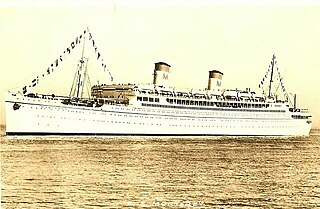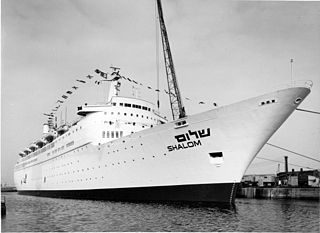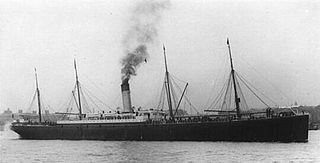Holland America Line is a British–American-owned cruise line, a subsidiary of Carnival Corporation & plc headquartered in Seattle, Washington, United States.

RMS Republic was a steam-powered ocean liner built in 1903 by Harland and Wolff in Belfast, and lost at sea in a collision in 1909 while sailing for the White Star Line. The ship was equipped with a new Marconi wireless telegraphy transmitter, and issued a CQD distress call, resulting in the saving of around 1,500 lives. Known as the "Millionaires' Ship" because of the number of wealthy Americans who traveled by her, she was described as a "palatial liner" and was the flagship of White Star Line's Boston service. This was the first important marine rescue made possible by radio, and brought worldwide attention to this new technology.

USS Comfort (AH-3) was a hospital ship for the United States Navy in World War I. She was the sister ship of USS Mercy (AH-4) but the two ships were not of a ship class. Comfort was known as SS Havana in passenger service for the Ward Line, and as USAT Havana in United States Army service before her Navy service. Her name was restored to Havana in 1927, and she was renamed SS Yucatán in 1935, and SS Agwileon in 1941. In World War II, she was known as USAT Agwileon and USAHS Shamrock in service for the United States Army.

SS Yarmouth Castle, built as Evangeline, was an American steamship whose loss in a disastrous fire in 1965 prompted new laws regarding safety at sea.

The Hamburg-Amerikanische Packetfahrt-Aktien-Gesellschaft (HAPAG), often referred to as Hamburg America Line, was a transatlantic shipping enterprise established in Hamburg, in 1847. Among those involved in its development were prominent citizens such as Albert Ballin, Adolph Godeffroy, Ferdinand Laeisz, Carl Woermann, August Bolten, and others, and its main financial backers were Berenberg Bank and H. J. Merck & Co. It soon developed into the largest German, and at times the world's largest, shipping company, serving the market created by German immigration to the United States and later immigration from Eastern Europe. On 1 September 1970, after 123 years of independent existence, HAPAG merged with the Bremen-based North German Lloyd to form Hapag-Lloyd AG.

SS Borinquen, the Taino language name for Puerto Rico, was a passenger liner launched 24 September 1930 and delivered to the Atlantic, Gulf & West Indies Steamship Lines (AGWI) in 1931 for operation by its subsidiary the New York & Porto Rico Line. The line operated the ship until it was requisitioned by the War Shipping Administration (WSA) the last day of 1941 for service as a troop transport. The line then operated the ship as agent for the WSA until 6 May 1944 when operation was transferred to the United States Army for support of the Normandy landings with the ship arriving off the beaches on 7 June 1944. Borinquen continued service post war until redelivered to the owners 14 June 1946. The ship was sold in 1949 and became the Arosa Star. After further sales and change in the cruise ship regulations the ship was again sold and grounded as La Jenelle on the California coast in 1970.

The Pacific Mail Steamship Company was founded April 18, 1848, as a joint stock company under the laws of the State of New York by a group of New York City merchants. Incorporators included William H. Aspinwall, Edwin Bartlett, Henry Chauncey, Mr. Alsop, G.G. Howland and S.S. Howland.

SS America was an ocean liner and cruise ship built in 1940 for the United States Lines and designed by the noted American naval architect William Francis Gibbs. She carried many names in the 54 years between her construction and her 1994 wreck:

SS Galileo Galilei was an ocean liner built in 1963 by Cantieri Riuniti dell' Adriatico, Monfalcone, Italy for Lloyd Triestino's Italy—Australia service. In 1979, she was converted to a cruise ship, and subsequently sailed under the names Galileo and Meridian. She sank in the Strait of Malacca in 1999 as the Sun Vista.

SS Valencia was an iron-hulled passenger steamer built for the Red D Line for service between Venezuela and New York City. She was built in 1882 by William Cramp and Sons, one year after the construction of her sister ship Caracas. She was a 1,598 ton vessel, 252 feet (77 m) in length. In 1897, Valencia was deliberately attacked by the Spanish cruiser Reina Mercedes off Guantanamo Bay, Cuba. The next year, she became a coastal passenger liner on the U.S. West Coast and served periodically in the Spanish–American War as a troopship to the Philippines. Valencia was wrecked off Cape Beale, which is near Clo-oose, on the west coast of Vancouver Island, British Columbia, on 22 January 1906. Since her sinking killed 100 people, some classify the wreck of Valencia as the worst maritime disaster in the "Graveyard of the Pacific", a famously treacherous area off the southwest coast of Vancouver Island.

SS Independence was an American ocean liner, then cruise ship which entered service in February 1951 for American Export Lines. Between 1974 and 1982 the vessel sailed as Oceanic Independence for Atlantic Far East Lines and American Hawaii Cruises, before reverting to the original name. Independence was then operated by American Global Line between 1982 and 1996, and again American Hawaii Cruises until being laid up in San Francisco in 2001.

Balmoral is a cruise ship owned and operated by Fred. Olsen Cruise Lines. She was built in 1988 by the Meyer Werft shipyard in Papenburg, West Germany, as Crown Odyssey for Royal Cruise Line. She has also sailed for the Norwegian Cruise Line as Norwegian Crown and Orient Lines as Crown Odyssey. In 2007–2008 she was lengthened by 30 m (98 ft) at the Blohm + Voss shipyard in Hamburg prior to entering service with her current operator.

SS Monterey was a luxury ocean liner launched on 10 October 1931. The ship was completed April 1932 and is shown in registers as a 1932 ship. Monterey was the third of the four ships of the Matson Lines "White Fleet", which were designed by William Francis Gibbs and also included SS Malolo, SS Mariposa and SS Lurline. Monterey was identical to Mariposa and very similar to Lurline. During World War II Monterey was used as a troopship operated by Matson as agents of the War Shipping Administration (WSA). Monterey was a large, fast transport capable of sailing independently and was allocated to serving Army troop transport requirements. The ship was involved in an attack on a convoy near Cape Bougaroun.

MV Astoria was constructed as the transatlantic liner MS Stockholm in 1948 for Swedish American Line, and rebuilt as a cruise ship in 1993. At 72 years old, she was the oldest passenger liner still sailing in deep water routes. As Stockholm, she was best known for an accidental collision with Andrea Doria in July 1956, resulting in the sinking of the latter ship and 46 fatalities off the coast of Nantucket.

SS Shalom was a combined ocean liner/cruise ship built in 1964 by Chantiers de l'Atlantique, St Nazaire, France, for ZIM Lines, Israel, for transatlantic service from Haifa to New York. In 1967, SS Shalom was sold to the German Atlantic Line, becoming their second SS Hanseatic. Subsequently she served as SS Doric for Home Lines, SS Royal Odyssey for Royal Cruise Line and SS Regent Sun for Regency Cruises. The ship was laid up in 1995 following the bankruptcy of Regency Cruises. Numerous attempts were made to bring her back to service, but none were successful. The ship sank outside Cape St. Francis, South Africa, on 26 July 2001, while en route to India to be scrapped.

RMS Carinthia was an ocean liner built in 1956 as one of the four Saxonia class ships. She sailed for Cunard Line from her completion until 1968 when she was sold to Sitmar Line, rebuilt into a full-time cruise ship and renamed SS Fairsea. She sailed with Sitmar until 1988, when Sitmar was sold to P&O. She was renamed SS Fair Princess and sailed for Princess Cruises and P&O Cruises until 2000. She was then sold to China Sea Cruises and renamed SS China Sea Discovery. In 2005 or 2006 she was scrapped in Alang, India.

Fort Victoria was a 7,784 GRT cruise ship which was built in 1912 as Willochra. During the First World War she was requisitioned for use as a troopship. In 1920 she was sold and renamed Fort Victoria, serving until lost in a collision in 1929.

SS Armenian was an 1895-built British cargo liner built for the Leyland Line, but managed by the White Star Line from 20 March 1903. She was employed on the cargo service between Liverpool and New York City, with the passenger service between the two ports having been previously withdrawn. In 1910 she was repainted in the Leyland livery.

SS Wandilla was a steamship built in 1912 for the Adelaide Steamship Company. The ship operated on the Fremantle to Sydney run until 1915, when she was acquired for military service and redesignated HMAT Wandilla. Initially used as a troop transport, the vessel was converted to a hospital ship in 1916. Wandilla was returned to her owners at the end of the war, then was sold to the Bermuda & West Indies SS Company and renamed Fort St. George in 1921. She was sold in 1935 to Lloyd Triestino and renamed Cesarea before being renamed Arno in 1938. At the start of World War II, the ship was acquired by the Regia Marina for use as a hospital ship. She was sunk by British aircraft on 10 September 1942.

SS New Australia was a UK-built turbo-electric passenger steamship that had a varied career from 1931 to 1966. She was built as the ocean liner Monarch of Bermuda, was a troop ship in the Second World War and was damaged by fire in 1947.



















